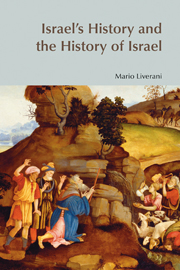Book contents
- Frontmatter
- Dedication
- Contents
- List of Tables and Illustrations
- Foreword
- Abbreviations
- IMPRINTING
- Part I A NORMAL HISTORY
- INTERMEZZO
- Part II AN INVENTED HISTORY
- Chapter 13 RETURNEES AND ‘REMAINEES’: THE INVENTION OF THE PATRIARCHS
- Chapter 14 RETURNEES AND ALIENS: THE INVENTION OF THE CONQUEST
- Chapter 15 A NATION WITHOUT A KING: THE INVENTION OF THE JUDGES
- Chapter 16 THE ROYAL OPTION: THE INVENTION OF THE UNITED MONARCHY
- Chapter 17 THE PRIESTLY OPTION: THE INVENTION OF THE SOLOMONIC TEMPLE
- Chapter 18 SELF-IDENTIFICATION: THE INVENTION OF THE LAW
- EPILOGUE
- Bibliography
- Index of References
- Index of Names of Persons and Deities
- Index of Placenames
Chapter 17 - THE PRIESTLY OPTION: THE INVENTION OF THE SOLOMONIC TEMPLE
from Part II - AN INVENTED HISTORY
- Frontmatter
- Dedication
- Contents
- List of Tables and Illustrations
- Foreword
- Abbreviations
- IMPRINTING
- Part I A NORMAL HISTORY
- INTERMEZZO
- Part II AN INVENTED HISTORY
- Chapter 13 RETURNEES AND ‘REMAINEES’: THE INVENTION OF THE PATRIARCHS
- Chapter 14 RETURNEES AND ALIENS: THE INVENTION OF THE CONQUEST
- Chapter 15 A NATION WITHOUT A KING: THE INVENTION OF THE JUDGES
- Chapter 16 THE ROYAL OPTION: THE INVENTION OF THE UNITED MONARCHY
- Chapter 17 THE PRIESTLY OPTION: THE INVENTION OF THE SOLOMONIC TEMPLE
- Chapter 18 SELF-IDENTIFICATION: THE INVENTION OF THE LAW
- EPILOGUE
- Bibliography
- Index of References
- Index of Names of Persons and Deities
- Index of Placenames
Summary
Palestinian and Babylonian an Temples
With its prospect of a powerful and pan-Israelite kingdom, the monarchic option was purely utopian: effectively the royal house no longer had any momentum, an independent kingdom was incompatible with the imperial situation, and those who returned came only from Judah and Benjamin. At times, utopias win the day, but in this case the vision was retrograde and conservative, an attempt to return to a now obsolete past. It was defeated by another utopia, the priestly vision, projected into the future and pursued with great determination. In theory this envisaged God's direct sovereignty: Yahweh mālak, ‘God reigns’, as the Psalms say, once royal but now adapted to this new ideology:
Yahweh opens the eyes of the blind.
Yahweh lifts up those who are bowed down;
Yahweh loves the righteous.
Yahweh watches over the strangers;
he upholds the orphan and the widow,
but the way of the wicked he brings to ruin.
Yahweh will reign forever,
your God, O Zion, for all generations
(Ps. 146.8–10).However, in practice the kingdom of God should be created by giving priests a political role and organizing the Judean community as a temple-city – a totally innovative solution in the history of Palestine.
In Palestine, and throughout the Levant, temples had always played a strictly cultic role. ‘Houses’ of various city gods (hence conceived as their dwellings), these temples were quite small, with a simple architectural structure comprising a vestibule, a sanctuary and an inner sanctum.
- Type
- Chapter
- Information
- Israel's History and the History of Israel , pp. 324 - 341Publisher: Acumen PublishingPrint publication year: 2005



